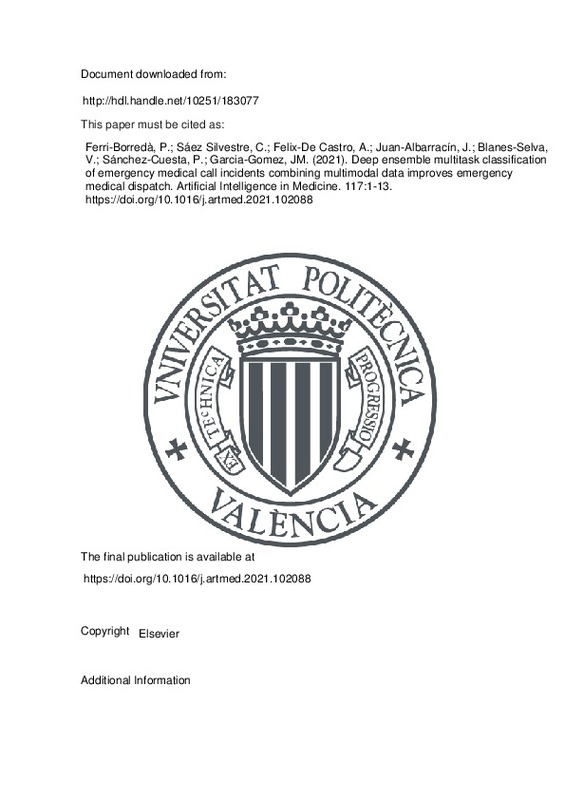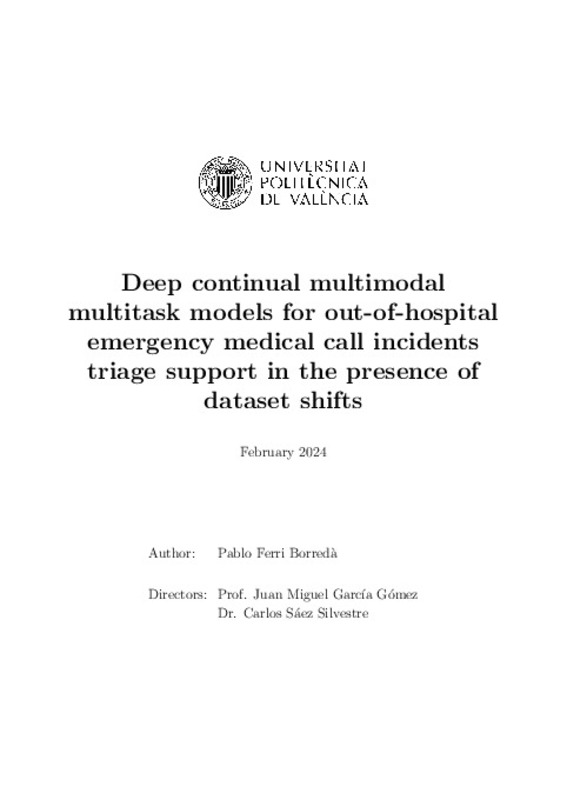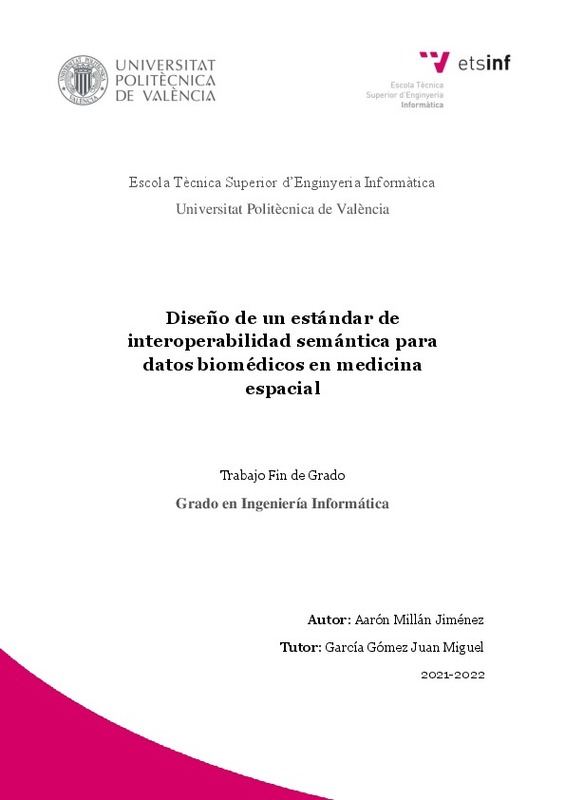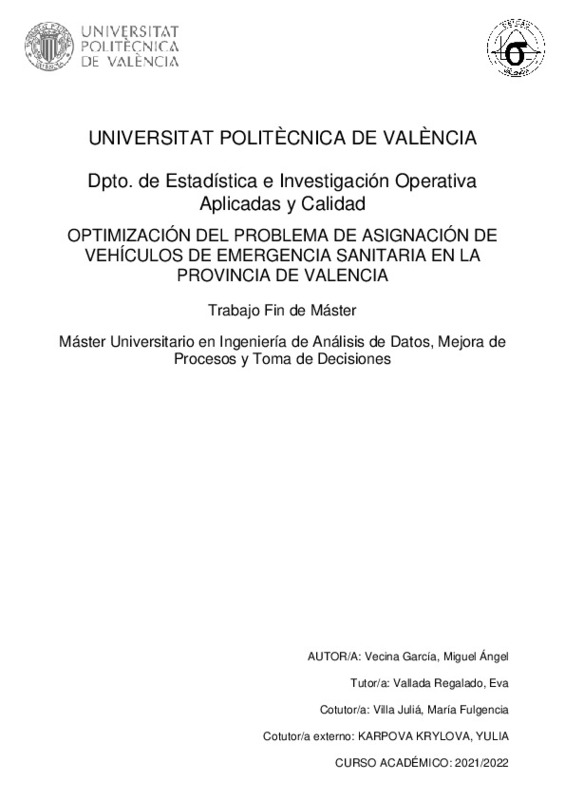JavaScript is disabled for your browser. Some features of this site may not work without it.
Buscar en RiuNet
Listar
Mi cuenta
Estadísticas
Ayuda RiuNet
Admin. UPV
Deep ensemble multitask classification of emergency medical call incidents combining multimodal data improves emergency medical dispatch
Mostrar el registro sencillo del ítem
Ficheros en el ítem
| dc.contributor.author | Ferri-Borredà, Pablo
|
es_ES |
| dc.contributor.author | Sáez Silvestre, Carlos
|
es_ES |
| dc.contributor.author | Felix-De Castro, Antonio
|
es_ES |
| dc.contributor.author | Juan-Albarracín, Javier
|
es_ES |
| dc.contributor.author | Blanes-Selva, Vicent
|
es_ES |
| dc.contributor.author | Sánchez-Cuesta, Purificación
|
es_ES |
| dc.contributor.author | Garcia-Gomez, Juan M
|
es_ES |
| dc.date.accessioned | 2022-06-03T18:02:15Z | |
| dc.date.available | 2022-06-03T18:02:15Z | |
| dc.date.issued | 2021-07 | es_ES |
| dc.identifier.issn | 0933-3657 | es_ES |
| dc.identifier.uri | http://hdl.handle.net/10251/183077 | |
| dc.description.abstract | [EN] The objective of this work was to develop a predictive model to aid non-clinical dispatchers to classify emergency medical call incidents by their life-threatening level (yes/no), admissible response delay (undelayable, minutes, hours, days) and emergency system jurisdiction (emergency system/primary care) in real time. We used a total of 1 244 624 independent incidents from the Valencian emergency medical dispatch service in Spain, compiled in retrospective from 2009 to 2012, including clinical features, demographics, circumstantial factors and free text dispatcher observations. Based on them, we designed and developed DeepEMC2, a deep ensemble multitask model integrating four subnetworks: three specialized to context, clinical and text data, respectively, and another to ensemble the former. The four subnetworks are composed in turn by multi-layer perceptron modules, bidirectional long short-term memory units and a bidirectional encoding representations from transformers module. DeepEMC2 showed a macro F1-score of 0.759 in life-threatening classification, 0.576 in admissible response delay and 0.757 in emergency system jurisdiction. These results show a substantial performance increase of 12.5 %, 17.5 % and 5.1 %, respectively, with respect to the current in-house triage protocol of the Valencian emergency medical dispatch service. Besides, DeepEMC2 significantly outperformed a set of baseline machine learning models, including naive bayes, logistic regression, random forest and gradient boosting (¿ = 0.05). Hence, DeepEMC2 is able to: 1) capture information present in emergency medical calls not considered by the existing triage protocol, and 2) model complex data dependencies not feasible by the tested baseline models. Likewise, our results suggest that most of this unconsidered information is present in the free text dispatcher observations. To our knowledge, this study describes the first deep learning model undertaking emergency medical call incidents classification. Its adoption in medical dispatch centers would potentially improve emergency dispatch processes, resulting in a positive impact in patient wellbeing and health services sustainability. | es_ES |
| dc.description.sponsorship | This work has been supported by the Valencian agency for security and emergency response project A1800173041, the Ministry of Science, Innovation and Universities of Spain program FPU18/06441 and the EU Horizon 2020 project InAdvance 825750 | es_ES |
| dc.language | Inglés | es_ES |
| dc.publisher | Elsevier | es_ES |
| dc.relation.ispartof | Artificial Intelligence in Medicine | es_ES |
| dc.rights | Reconocimiento - No comercial - Sin obra derivada (by-nc-nd) | es_ES |
| dc.subject | Medical emergencies | es_ES |
| dc.subject | Emergency medical calls | es_ES |
| dc.subject | Emergency medical dispatch | es_ES |
| dc.subject | Deep learning | es_ES |
| dc.subject | Ensemble learning | es_ES |
| dc.subject | Multitask learning | es_ES |
| dc.subject.classification | FISICA APLICADA | es_ES |
| dc.title | Deep ensemble multitask classification of emergency medical call incidents combining multimodal data improves emergency medical dispatch | es_ES |
| dc.type | Artículo | es_ES |
| dc.identifier.doi | 10.1016/j.artmed.2021.102088 | es_ES |
| dc.relation.projectID | info:eu-repo/grantAgreement/ARC/Linkage Projects/LP0775530/AU | es_ES |
| dc.relation.projectID | info:eu-repo/grantAgreement/AVSRE//A1800173041/ | es_ES |
| dc.relation.projectID | info:eu-repo/grantAgreement/EC/H2020/825750/EU | es_ES |
| dc.rights.accessRights | Abierto | es_ES |
| dc.contributor.affiliation | Universitat Politècnica de València. Departamento de Física Aplicada - Departament de Física Aplicada | es_ES |
| dc.description.bibliographicCitation | Ferri-Borredà, P.; Sáez Silvestre, C.; Felix-De Castro, A.; Juan-Albarracín, J.; Blanes-Selva, V.; Sánchez-Cuesta, P.; Garcia-Gomez, JM. (2021). Deep ensemble multitask classification of emergency medical call incidents combining multimodal data improves emergency medical dispatch. Artificial Intelligence in Medicine. 117:1-13. https://doi.org/10.1016/j.artmed.2021.102088 | es_ES |
| dc.description.accrualMethod | S | es_ES |
| dc.relation.publisherversion | https://doi.org/10.1016/j.artmed.2021.102088 | es_ES |
| dc.description.upvformatpinicio | 1 | es_ES |
| dc.description.upvformatpfin | 13 | es_ES |
| dc.type.version | info:eu-repo/semantics/publishedVersion | es_ES |
| dc.description.volume | 117 | es_ES |
| dc.identifier.pmid | 34127234 | es_ES |
| dc.relation.pasarela | S\438859 | es_ES |
| dc.contributor.funder | Australian Research Council | es_ES |
| dc.contributor.funder | COMISION DE LAS COMUNIDADES EUROPEA | es_ES |
| dc.contributor.funder | MINISTERIO DE CIENCIA INNOVACION Y UNIVERSIDADES | es_ES |
| dc.contributor.funder | Agencia Valenciana de Seguridad y Respuesta a las Emergencias | es_ES |







![[Cerrado]](/themes/UPV/images/candado.png)




